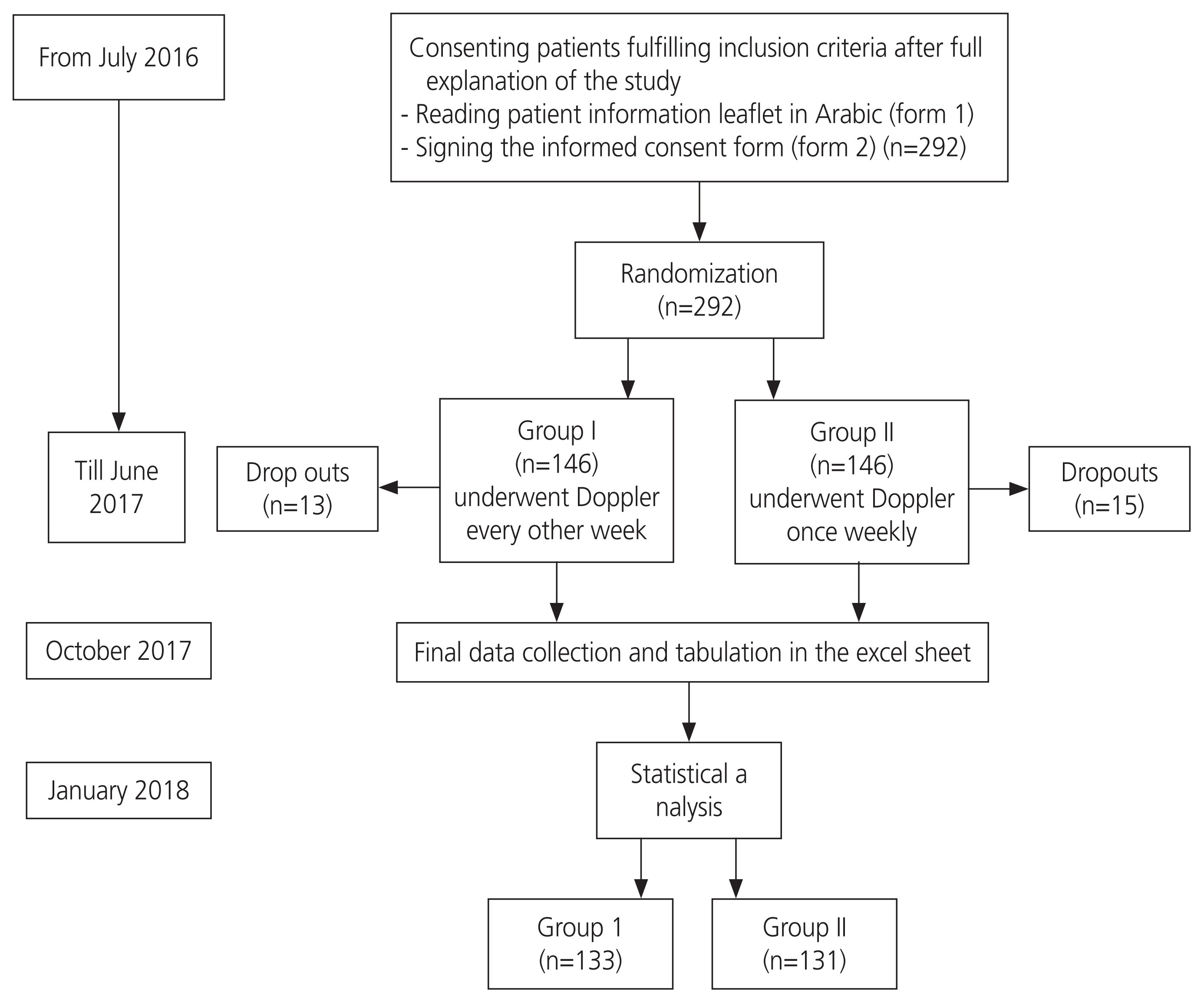Obstet Gynecol Sci.
2023 May;66(3):161-168. 10.5468/ogs.22130.
Frequency of third trimester umbilical artery Doppler for improving neonatal outcomes in high-risk pregnancies: a randomized trial
- Affiliations
-
- 1Department of Obstetrics and Gynecology, Faculty of medicine, Ain Shams University, Cairo, Egypt
- 2Nasr City Insurance Hospital, Cairo, Egypt
- KMID: 2542222
- DOI: http://doi.org/10.5468/ogs.22130
Abstract
Objective
Umbilical artery Doppler ultrasonography is useful for high-risk prenatal surveillance. However, according to a systematic review and meta-analysis by the Cochrane pregnancy and childbirth group, the optimal frequency with which such surveillance should occur remains unclear. In the current study, we aimed to investigate whether performing umbilical artery Doppler on a weekly basis enables earlier detection of changes in utero-placental blood flow than the recommended bi-weekly (i.e., fortnightly) regimen and its impact on perinatal outcomes.
Methods
This randomized controlled study included 292 high-risk pregnant women in their third trimester who attended the Ain Shams University Maternity Hospital in Egypt from January 2018 to September 2019. The women were randomly assigned to two groups to undergo either bi-weekly or once-weekly umbilical artery Doppler ultrasound.
Results
In the primary analysis performed according to the intention-to-treat basis, we observed no difference in the primary outcome of fetal admission to the neonatal intensive care unit (NICU) within the first 24 hours (risk difference, -2.63; 95% confidence interval, -12.92 to 7.65). Furthermore, no significant differences in secondary outcomes were observed (apart from stillbirth).
Conclusion
Weekly umbilical artery Doppler is not superior to bi-weekly surveillance in preventing admission to the NICU and most other studied outcomes. Therefore, the bi-weekly regiment may be more convenient for women and more cost-effective for health care organizations (trial registration: NCT03584763 at clinicaltrials.gov).
Figure
Reference
-
References
1. Narayan H. Introduction. Compendium for the antenatal care of high risk pregnancies. 1st ed.Oxford;Oxford University Press;2015.2. Gaccioli F, Lager S, Powell TL, Jansson T. Placental transport in response to altered maternal nutrition. J Dev Orig Health Dis. 2013; 4:101–15.
Article3. Farina R, Pennisi F, La Rosa M, Puglisi C, Di Benedetto A, Campisi G, et al. Functional study of the transplanted kidney with power Doppler US and time/intensity curves. Radiol Med. 2007; 112:64–73.
Article4. Imdad A, Yakoob MY, Siddiqui S, Bhutta ZA. Screening and triage of intrauterine growth restriction (IUGR) in general population and high risk pregnancies: a systematic review with a focus on reduction of IUGR related stillbirths. BMC Public Health. 2011; 11Suppl 3(Suppl 3):S1.
Article5. Grivell RM, Wong L, Bhatia V. Regimens of fetal surveillance for impaired fetal growth. Cochrane Database Syst Rev. 2012; 2012:CD007113.
Article6. Hadlock FP, Harrist RB, Sharman RS, Deter RL, Park SK. Estimation of fetal weight with the use of head, body, and femur measurements--a prospective study. Am J Obstet Gynecol. 1985; 151:333–7.
Article7. Alfirevic Z, Stampalija T, Dowswell T. Fetal and umbilical Doppler ultrasound in high-risk pregnancies. Cochrane Database Syst Rev. 2017; 6:CD007529.
Article8. Zimmermann P, Eiriö V, Koskinen J, Kujansuu E, Ranta T. Doppler assessment of the uterine and uteroplacental circulation in the second trimester in pregnancies at high risk for pre-eclampsia and/or intrauterine growth retardation: comparison and correlation between different Doppler parameters. Ultrasound Obstet Gynecol. 1997; 9:330–8.
Article9. Nienhuis SJ, Vles JS, Gerver WJ, Hoogland HJ. Doppler ultrasonography in suspected intrauterine growth retardation: a randomized clinical trial. Ultrasound Obstet Gynecol. 1997; 9:6–13.
Article10. Al Qahtani N. Doppler ultrasound in the assessment of suspected intra-uterine growth restriction. Ann Afr Med. 2011; 10:266–71.
Article11. McCowan LM, Harding JE, Roberts AB, Barker SE, Ford C, Stewart AW. A pilot randomized controlled trial of two regimens of fetal surveillance for small-for-gestationalage fetuses with normal results of umbilical artery Doppler velocimetry. Am J Obstet Gynecol. 2000; 182(1 Pt 1):81–6.
Article
- Full Text Links
- Actions
-
Cited
- CITED
-
- Close
- Share
- Similar articles
-
- Umbilical Artery Doppler Velocimetry in Small for Gestational Age Fetuses
- The efficacy of umbilical artery blood flow velocity waveform to predict the perinatal outcome of term pregnancies with small for gestational age
- Pseudo-Single Umbilical Artery by Spontaneous Intrauterine Umbilical Artery Thrombosis
- The Clinical Significance of Early Diastolic Notch of Uterine Artery Doppler Waveform Analysis in the Second Trimester
- The clinical impact of absent or reversed end-diastolic velocity in the umbilical artery before the 34th week of pregnancy


